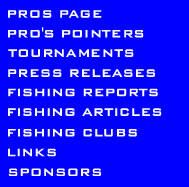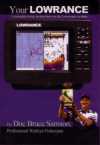
Click
here for Bruce Samson's Great New Instructionsal Interactive
DVD
|
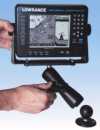
Ram 111-U The ultimate Electronics mount
Click
here for more info
or to order |

Beautiful Musky and Outdoor
Prints! |
|
Fishing articles from Walleyes Inc
|
By Ted Takasaki and Scott Richardson
|
Rivers pulsate with life in spring. In all rivers and reservoirs, walleye and sauger will charge upstream and collect in huge numbers just below dams or rapids. After they spawn, the fish travel back into the reservoir or just spread out in smaller schools downstream in search of food.
The time between the charge upstream and the retreat downstream offers some of the best fishing of the year. Every strike may be an egg-laden female at her heaviest. Big fish packed in tight schools are the stuff of dreams.
Rivers also offer some of the biggest challenges of the year. It can be tough to control your boat in current and to present a lure precisely where it needs to be. This is all while keeping an eye out for big commercial ships cruising by.
Yes, there’s a lot to consider. What is the best course? K.I.S.S., Keep It Simple for Success. Start by breaking challenges down to manageable tasks.
Start with location. Rivers change daily, in fact hourly, as water levels rise or fall. But no matter what the river, the same principles always hold true. Seen one river, seen them all is true.
The K.I.S.S. approach is to realize that walleye and sauger concentrate in bunches during the spring. There are often tons of boats which highlight the community spots. Start by fishing out and around the boats, but don’t crowd anyone. Most of the boats won’t stay long on spots without fish. Most commercial produced maps give away the hot spots. Buy one.
Find your own spots by taking a longer look at that map. Focus on the bends where the natural flow of the river is broken as the water changes direction. Walleyes and sauger will conserve their energy or lay their eggs in the slacker water of the flats on the inside turns.
Current also concentrates fish behind natural and artificial structure which slows moving water even more. Resting fish can slide behind the current break. Feeding fish can slide in front or to the side of the structure closer to the current.
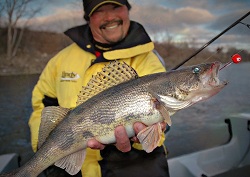
Rivers teem with life in spring, and you can find your own mother lode of walleyes and saugers by following Ted Takasaki’s proven, simple system |
Current breaks range from points that form slack water behind them called eddies to wing dams where an area of slower current forms along the bottom on the upstream side of the face. Water slows on the front and back of bridge abutments or even trees lying in the water. Holes in the bottom create current breaks.
Are you faced with high water and fast current? Target the current break closer to shore. Slow current? Fish will be toward the end usually towards the middle of the river. Slack water will also form where current from a feeder creek or tributary meets the current of the main river. In spring when rain can cause runoff, those spots are also key if water from one source or the other is cleaner |
Another factor to consider - walleyes and sauger prefer hard bottom like gravel or even clam beds. Look for the transition areas where hard bottom meets mud.
Just remember, river bend plus current break equals fish. K.I.S.S.
You can typically eliminate long straight stretches of river. Walleyes and sauger will move through them as fast as they can because there’s nothing to hold them in any one spot. The exceptions might include points jutting into the main channel or even holes gouged in the bottom by current, dredging or the prop wash from barges or ship traffic.
River tactics are something else that too many people over-think. They shouldn’t.
K.I.S.S. instead.
Slipping downstream using jigs is among the oldest, simplest and most effective tactics. The bait must be on the bottom where the fish are. Some pros like to use the lightest jig possible. Thin braided line, like TUF-Line, helps with that process better than monofilament line by offering less water resistance. The braided is also more sensitive so light bites are detectable. Other pros prefer to use heavy jigs of ¾’s to 1 ounce no matter how fast the current or how deep the water. They believe bouncing the heavy weight on the bottom lets fish zero in on the bait.
K.I.S.S. for boat control means - chase the line. Use an electric trolling motor to follow the line and match boat speed to the current. The goal is to keep the jig vertical and directly below the boat to feel strikes better and avoid snags.
Add a stinger hook for getting light biters. Change up colors. Add a fathead minnow or chub. Experiment by putting different actions on your jig. Try holding the bait steady just off the bottom, drag it, bounce it slowly, or really snap it. Let the fish tell you what they want.
Upstream trolling is also effective, especially in dinghy water. If water is dirty, a walleye or sauger facing upstream may not have enough visibility to see, turn, and attack a jig moving downstream. But that same fish might be able to focus on a crankbait or live bait on a three-way rig moving by from the side and to the front.
Three-way rigs are simple, too. A three-way swivel tied to the main line holds a dropper to a weight or a big jig and a 3 to 4 foot leader to a floating crankbait, or a plain hook or a floating jighead (tipped with a minnow). A small bead in front of the hook would add color. Motor upstream through eddies with the trolling motor at the speed of a slow walk. Faster current may require using a gasoline kicker.
Trolling crankbaits with leadcore line is another tactic that is made too complicated. Use medium-action rods, like St. Croix’s Avid AVC106HM2 and spool up 18-pound leadcore line on a large baitcasting reel.
Peel back the nylon sheath, remove about 3 inches of leadcore, tie on a small #12 barrel swivel, a 3 to 10 foot green TUF-Line leader, a crankbait snap and the lure. Start trolling at 2 mph or faster to cover more water. Run from river bend to river bend and troll each one. Leadcore runs deeper at slow speeds and shallower at faster speeds due to water resistance. Watch your GPS or speedometer on the sonar screen. Try to get your crankbait to run just off of the bottom by keeping track of the combination of speed and line out.
Simple is better when it comes to rivers. K.I.S.S.
|
|
Please
Check Out these links below to our site Sponsors |
|
|
|
|
|
|
|
|
|
|
|
|
|
|
|
|
|
|
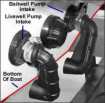
Survivor Livewell Intake System on "The
Run"
Click
Here For
More Information
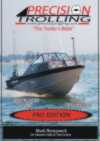
New Precision Trolling Pro Edition With Plastic Pages and
Easily Updateable click
here for more information
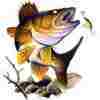
Check
out our T-shirt Line Now in colors and long sleeves
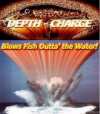
Church Tackles Walleye Planer Board

Click
here for more info or to order on-line
 Walleyes
Inc. Pro Team Team Favorites Lodging,
food,tackle, equipment and more Walleyes
Inc. Pro Team Team Favorites Lodging,
food,tackle, equipment and more
|

